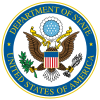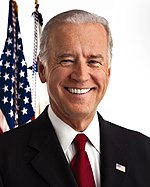User:Nicholasc1/Executive Branch of the United States
Executive branch
[edit]The executive power in the Federal Government is vested in the President of the United States,[1] although power is often delegated to the Cabinet members and other officials.[2][3]The role of the executive branch is to administer state bureaucracy[4], oversee the state's ambassadors and determine foreign policy, and for the president, act as commander in chief;commanding the state's armed forces and determining military policy.[5] The executive branch is composed of the the President and Vice President who are elected as running mates by the Electoral College, for which each state, as well as the District of Columbia, is allocated a number of seats based on its representation (or ostensible representation, in the case of D.C.) in both houses of Congress.[1][6] The President is limited to a maximum of two[7] four-year terms[1]. It also contains the United States Cabinet, who's leaders are senior officers chosen by the President, and a variety of departments and agencies such as the EPA (environmental protection agency).[8][9]
President
[edit]| President of the United States of America | |
|---|---|
 | |
since January 20, 2009 | |
| Style | Mr. President[10] (Informal) The Honorable[11] (Formal) |
| Residence | White House |
| Term length | Four years, renewable once |
| Inaugural holder | George Washington April 30, 1789 |
| Formation | United States Constitution March 4, 1789 |
| Website | whitehouse.gov/president |
The executive branch consists of the President and delegates. The President is both the head of state and government, as well as the military commander-in-chief and chief diplomat. The President, according to the Constitution, must "take care that the laws be faithfully executed", and "preserve, protect, and defend the Constitution". The President presides over the executive branch of the Federal Government, a vast organization numbering about 4 million people, including 1 million active-duty military personnel. The forty-fourth and current president is Barack Obama.
The President may sign legislation passed by Congress into law or may veto it, preventing it from becoming law unless two-thirds of both houses of Congress vote to override the veto. The President may, with the consent of two-thirds of the Senate, make treaties with foreign nations. The President may be impeached by a majority in the House and removed from office by a two-thirds majority in the Senate for "treason, bribery, or other high crimes and misdemeanors". The President may not dissolve Congress or call special elections but does have the power to pardon, or release, criminals convicted of offenses against the Federal Government (except in cases of impeachment), enact executive orders, and (with the consent of the Senate) appoint Supreme Court justices and federal judges.
President Main article: President of the United States
The executive branch consists of the President and those to whom the President's powers are delegated. The forty- fourth and current president is Barack Obama. The President is both the head of state and government, as well as the military commander-in-chief and chief diplomat. The President, according to the Constitution, must "take care that the laws be faithfully executed", and "preserve, protect and defend the Constitution". The President presides over the executive branch of the Federal Government, a vast organization numbering about 4 million people, including 1 million active-duty military personnel.
The President may sign legislation passed by Congress into law or may veto it, preventing it from becoming law unless two-thirds of both houses of Congress vote to override the veto. The President may, with the consent of two-thirds of the Senate, make treaties with foreign nations. The President may be impeached by a majority in the House and removed from office by a two-thirds majority in the Senate for "treason, bribery, or other high crimes and misdemeanors". The President may not dissolve Congress or call special elections but does have the power to pardon, or release, criminals convicted of offenses against the Federal Government (except in cases of impeachment), enact executive orders, and (with the consent of the Senate) appoint Supreme Court justices and federal judges.
The president is indirectly elected by the people through the Electoral College to a four-year term, and is one of only two nationally elected federal officers, the other being the Vice President of the United States. The Twenty-second Amendment, adopted in 1951, prohibits anyone from being elected to the presidency for a third full term. In all, 43 individuals have served 55 four-year terms.
Vice President
[edit]| Vice President of the United States of America | |
|---|---|
 | |
since January 20, 2009 | |
| Style | Mr. Vice President (Informal) The Honorable (Formal) Mr. President (As presiding officer of the Senate) |
| Residence | Number One Observatory Circle |
| Term length | Four years |
| Formation | U.S. Constitution March 4, 1789 |
| Succession | First |
| Website | Joseph R. Biden, the serving Vice President of the United States. |
The Vice President is the second-highest executive official in rank of the government. As first in the U.S. presidential line of succession, the Vice President becomes President upon the death, resignation, or removal of the President, which has happened nine times in U.S. history. Under the Constitution, the Vice President is President of the Senate. When the vice president is not there the President Pro-Template is in charge of day to day issues. By virtue of this role, he or she is the head of the Senate. In that capacity, the Vice President is allowed to vote in the Senate, but only when necessary to break a tied vote. Pursuant to the Twelfth Amendment, the Vice President presides over the joint session of Congress when it convenes to count the vote of the Electoral College. While the Vice President's only constitutionally prescribed functions, aside from presidential succession, relate to his role as President of the Senate, the office is now commonly viewed as a member of the executive branch of the Federal Government. The U.S. Constitution does not expressly assign the office to any one branch, causing scholars to dispute whether it belongs to the executive branch, the legislative branch, or both.[12][13]
Secretary of State
[edit]| United States Secretary of State | |
|---|---|
 Official seal | |
since January 21, 2009 | |
| United States Department of State | |
| Appointer | The President of United States |
| Succession | Fourth |
| Website | www.state.gov |
The Secretary of State is the Chief Executive Officer of the United States Department of State, the most senior of all federal executive departments. The Secretary of State is appointed by the President of the United States. The Secretary of State is the third-highest official of the executive branch of the Federal Government of the United States, after the President and Vice President. The Secretary is a member of the President's Cabinet and the highest-ranking cabinet secretary both in the presidential line of succession and order of precedence. The Secretary has many duties and responsibilities.[14] The Secretary serves as the President's chief adviser on U.S. foreign policy and as such negotiates, interprets, and terminates treaties and agreements, personally participates in or directs U.S. representatives to international conferences, organizations, and agencies, conducts negotiations relating to U.S. foreign affairs, and is responsible for the administration and management of foreign embassies and consulate offices. Foreign trade missions and intelligence assets report directly to the Secretary of State. The Secretary is also responsible for overall direction, coordination, and supervision of interdepartmental activities of the U.S. Government overseas. Most of the domestic functions of the Department of State have been transferred to other agencies. Those that remain include storage and use of the Great Seal of the United States, performance of protocol functions for the White House, and the drafting of certain proclamations. The Secretary also negotiates with the individual States over the extradition of fugitives to foreign countries. The Secretary answers directly to the President of the United States.[15]
Cabinet, executive departments, and agencies
[edit]The day-to-day enforcement and administration of federal laws is in the hands of various federal executive departments, created by Congress to deal with certain areas of national and international affairs. Their are various heads for each department. This includes the vice president and the heads of the 15 departments, chosen by the President and approved with the "advice and consent" of the U.S. Senate, form a council of advisers generally known as the President's Cabinet. In addition to departments, there are a number of staff organizations grouped into the Executive Office of the President. These include the White House staff, the National Security Council, the Office of Management and Budget, the Council of Economic Advisers, the Council on Environmental Quality, the Office of the U.S. Trade Representative, the Office of National Drug Control Policy and the Office of Science and Technology Policy. The employees in these certain United States government agencies are called federal civil servants.
There are also independent agencies such as the United States Postal Service, the National Aeronautics and Space Administration (NASA), the Central Intelligence Agency (CIA), the Environmental Protection Agency, and the United States Agency for International Development. In addition, there are government-owned corporations such as the Federal Deposit Insurance Corporation and the National Railroad Passenger Corporation.
Reflist
[edit]- ^ a b c Article II, Constitution of the United States of America
- ^ 3 U.S.C. §§ 301–303
- ^ Barack, Obama (2009-04-27). "Delegation of Certain Authority Under the National Defense Authorization Act for Fiscal Year 2008". United States. Retrieved 2009-07-01.
- ^ Executive Branch, www.dictionary.reference.com
- ^ Executive (government)
- ^ Amendment XXIII to the United States Constitution
- ^ Amendment XXII to the United States Constitution
- ^ United States Cabinet
- ^ Executive Branch, www.dictionary.reference.com
- ^ "How To Address The President; He Is Not Your Excellency Or Your Honor, But Mr. President". The New York Times. 1891-08-02.
- ^ "Models of Address and Salutation". Ita.doc.gov. Retrieved 2010-09-04.
- ^ Goldstein, Joel K. (1995). "The New Constitutional Vice Presidency". Wake Forest Law Review. 30 (505). Winston Salem, NC: Wake Forest Law Review Association, Inc.
- ^ Reynolds, Glenn Harlan (2007). "Is Dick Cheney Unconstitutional?". Northwestern University Law Review Colloquy. 102 (110). Chicago: Northwestern University School of Law.
- ^ United States Secretary of State
- ^ President of the United States.



